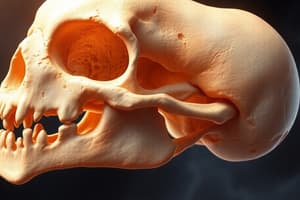Podcast
Questions and Answers
What condition involves the abnormal growth or swelling of bone?
What condition involves the abnormal growth or swelling of bone?
- Multiple myeloma
- Rickets
- Fibrous dysplasia (correct)
- Acromegaly
Which bone condition is primarily caused by a deficiency of vitamin D in children?
Which bone condition is primarily caused by a deficiency of vitamin D in children?
- Osteomyelitis
- Osteoporosis
- Rickets (correct)
- Paget’s disease
Which type of bone cancer is often linked to other carcinomas through metastasis?
Which type of bone cancer is often linked to other carcinomas through metastasis?
- Osteomyelitis
- Chondrosarcoma
- Fibrosarcoma
- Primary bone tumors (correct)
Which of the following conditions is characterized by an infection of the bone?
Which of the following conditions is characterized by an infection of the bone?
What is the primary effect of osteoporosis on bones?
What is the primary effect of osteoporosis on bones?
What is Paget’s disease primarily associated with?
What is Paget’s disease primarily associated with?
Which of these describes a common sign of multiple myeloma?
Which of these describes a common sign of multiple myeloma?
Which bone condition could occur as a secondary effect of chronic infection?
Which bone condition could occur as a secondary effect of chronic infection?
What is the significance of identifying radiolucent areas in bone imaging?
What is the significance of identifying radiolucent areas in bone imaging?
Which of the following statements about bone tumors is correct?
Which of the following statements about bone tumors is correct?
What is the primary function of osteoclasts in bone tissue?
What is the primary function of osteoclasts in bone tissue?
Which of the following is NOT a type of bone found in the human body?
Which of the following is NOT a type of bone found in the human body?
What is the general shape of cancellous or spongy bone?
What is the general shape of cancellous or spongy bone?
During which phase of bone healing is a fibrocartilaginous primary callus formed?
During which phase of bone healing is a fibrocartilaginous primary callus formed?
What type of ossification primarily occurs in the development of flat bones?
What type of ossification primarily occurs in the development of flat bones?
Which cellular structure carries blood vessels, lymph, and nerves in an osteon?
Which cellular structure carries blood vessels, lymph, and nerves in an osteon?
What mineral is the primary component of hydroxyapatite crystals found in bone?
What mineral is the primary component of hydroxyapatite crystals found in bone?
What is the primary role of the periosteum?
What is the primary role of the periosteum?
Which factor does NOT contribute to delayed bone healing?
Which factor does NOT contribute to delayed bone healing?
What percentage of fully developed bone tissue is typically made up of inorganic material?
What percentage of fully developed bone tissue is typically made up of inorganic material?
Flashcards are hidden until you start studying
Study Notes
Musculoskeletal System
- Bones collaborate with muscles and joints to support body structure and movement, known as the musculoskeletal system.
Types of Bones
- Long Bones: Characterized by a long shaft (diaphysis) with articular surfaces; examples include tibia and femur.
- Short Bones: Cube-shaped bones found in wrist and ankle.
- Flat Bones: Thin, curved bones, such as the occipital and parietal bones of the skull.
- Irregular Bones: Complicated shapes, like the vertebrae of the spine.
- Sesamoid Bones: Bones embedded within tendons; the patella is a prime example.
Functions of Bone
- Provides protection for vital organs.
- Maintains shape of the body.
- Facilitates movement in conjunction with muscles.
- Responsible for blood production in red bone marrow.
- Serves as a storage site for minerals, primarily calcium and phosphate.
Development of Bone
- Bone formation begins before birth and completes around age 25.
- Two main types of ossification: Intramembranous and Endochondral.
Bone Composition
- Fully developed bone is about 40-50% inorganic material (mainly calciums salts), 30-40% organic compounds (primarily collagen), and 20% water.
- Composed of osteocytes, collagen fibers, and an inorganic matrix.
Bone Structure
- Osteon (Haversian System): The fundamental unit of bone structure.
- Contains a central Haversian canal for blood vessels, lymph, and nerves.
- Compact Bone: Solid and dense; comprises approximately 80% of the skeleton and forms the outer layer of bones.
- Cancellous (Spongy) Bone: Lightweight and porous; contains red bone marrow, with no osteons present.
Periosteum
- Vascular fibrous membrane surrounding bone, providing nourishment, muscle attachment, and support for bone formation and repair.
Bone Healing Stages
- Formation of Primary Callus: Fibrocartilaginous callus forms shortly after injury.
- Resorption and Replacement: Dead bone is cleared, replaced by spongy bone; the size of the callus is influenced by activity at the fracture site.
- Formation of Secondary Callus: Bony bridge forms as spongy bone replaces the primary callus.
- Remodeling Stage: Bone reshapes to near-normal conditions; completion can take several years.
Factors Influencing Bone Healing
- Delays: Infection, tissue fragments, poor blood supply, old age, certain medications.
- Improvements: Resting the injury, pain-relieving medication, proper nutrition, guided movement, and younger age.
Common Bone Conditions
- Fractures: Broken bones caused by various means.
- Osteoporosis: Loss of bone density and strength, increasing fracture risk.
- Rickets: Vitamin D deficiency in children leading to improper bone growth.
- Osteomyelitis: Infection of the bone, commonly seen in long bones.
- Acromegaly: Abnormal growth of bones in hands, feet, and face.
- Fibrous Dysplasia: Abnormal bone growth.
- Paget’s Disease: Disordered bone remodeling.
- Bone Cancer: Includes primary cancers like osteosarcomas and chondrosarcomas, and secondary cancers that have metastasized from other organs.
Studying That Suits You
Use AI to generate personalized quizzes and flashcards to suit your learning preferences.




